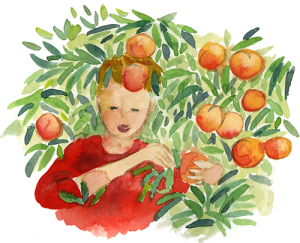Award Winning Author
Face Reading with Before & After Photos
When NOT to Eat Melon
Even though icicles bedeck the eaves here in my southern Oregon home, the markets are full of lush and wondrous fruits and vibrant salad greens that may look inviting but literally make you cold. This is because some foods have a chilling effect on the body that dampens our inner fire. While many foods are considered neutral, others have a heating effect and so better build and convey warmth. One of the foundations of Chinese medicine is that foods have hot, neutral or cold properties, which, if used wisely, will support our overall health.
So if you are bumping up the house thermostat because you’re feeling cold, then you might have a look in your fridge. Is it full of cooling foods like melons, peaches, lettuce, citrus, pineapple, juice, yogurt and ice cream? If so, something is not adding up.
When there’s an inner cold condition, the metabolism slows down, with symptoms such as pale complexion, loose stools, low energy, sluggish digestion, thin and watery mucus, low libido, cold extremities, edema and/or arthritic aches and pains appearing. If you have several of these symptoms, eating excessive cooling foods will intensify your suffering.
How to know if a food is cooling or warming? Generally speaking, meats are energetically warming, grains and beans are neutral and fruits and veggies tend to be cooling. While fruits are more cooling than vegetables, there are exceptions and gradations; for example, melon is more cooling than apples, and cherries are actually warming. The hot, neutral and cold properties of individual foods are detailed in my book The New Whole Foods Encyclopedia.
We use various cooking techniques to adjust and balance our foods. For example, the phrase “cool as a cucumber” aptly denotes that cucumbers are a “cold” food. But we can mitigate the cucumber’s cold by pickling it with some warming spices like garlic, dill and mustard seed. As a general rule, you might favor raw cucumbers as a warm weather food. Or if you’re hankering a cuke on a brisk day, enjoy it in combination with more warming dishes.
What are some examples of warming dishes? Foods cooked for a longer time period “absorb” and convey more warmth. So a baked apple is more warming than a steamed apple; but a steamed apple will convey more warmth than a raw apple or apple juice. To mitigate the cold of apple juice, simmer it with warming spices like cinnamon and allspice for a mug of hot cider. As oils and fat better hold and convey heat than does water, sautéed and fried foods are more warming than are steamed or boiled foods.
To enjoy balanced good health, we do well to enjoy a nutritious range of warming, cooling and neutral foods and make use a variety of cooking techniques adjusted to season and your specific needs and pleasure.
Outside the koi pond is frozen solid, but the steaming bowl of chili that I’m about to serve will warm me to the core. If I had come down with a fever, then a slice of watermelon would be medicinal, but otherwise I’ll wait on melon until the temperature climbs back up. If melon is what you find when you open your fridge on a winter day, consider wrapping it a slice of warming prosciutto.
For more information on the hot and cold properties of foods, see: Thermal Properties of Food and Veggies, and Vegetables–Best Raw or Cooked?


As always, your advice is sound and balanced. I love that you included information on the occasional need for a melon’s cooling properties as medicine, even in winter. For someone who is a walking menopausal heating system, cucumber works fine for me in winter. In fact, winter works fine for me. And my husband loves curling up to my hot flashes on the coldest of nights. I will make sure i serve him cucumbers that are pickled and set aside a few for me that are not. Thanks and warm cheers.
Thank you, Rebecca, such for an insightful article with relative links. I appreciate your wisdom!